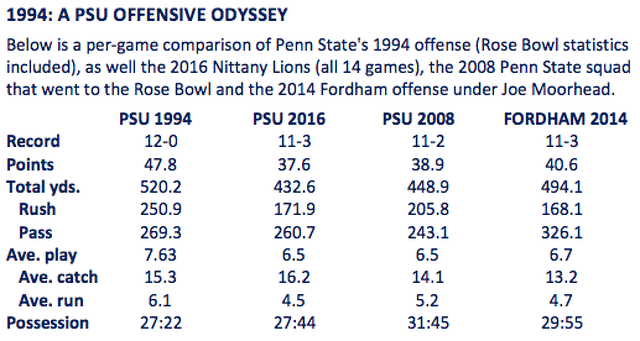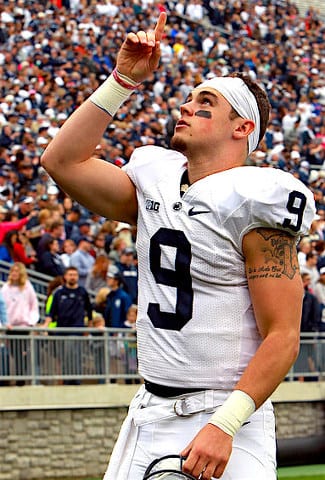Since he arrived at Penn State on Dec. 16, 2015, offensive coordinator Joe Moorhead’s No. 1 priority can boiled down to this:
#Moorpoints.
‘I have a base offensive structure that I believe in,’ said Moorhead on Day One, after arriving at PSU from Fordham.
‘But basically when it comes down to it, it is about putting points on the board. Specifically, scoring one more point than your defense allows.’
It’s 620 days later — and Penn State’s offense has definitely received the message.
One week into summer drills, preseason All-American tight end Mike Gesicki echoed those sentiments. Again.
‘Coach Moorhead said our No. 1 job is to put points on the board,’ Gesicki said.
Moorhead drove home that point early into camp, when he shared a chart of the most proficient — i.e., highest-scoring — offenses at PSU, dating back to 1887. And like the good student of Penn State football history that he is, Gesicki made a mental note of the team at No. 1.
‘1994 Penn State Nittany Lions,’ he shared with a characteristic grin. ‘It was the most successful team. They averaged 47.8 points.’
Gesicki was dead-on. Then, looking for some bonus points, he said the 1994 tight end — Kyle Brady — was a first-round NFL draft pick in 1995 (the year Gesicki was born).
Moorhead’s impact was immediate and obvious. With first-year starting quarterback Trace McSorley and sophomore running back Saquon Barkley in the backfield, and a receiving corps led by Gesicki and future NFL third-round draft pick Chris Godwin at wide receiver, the Nittany Lions averaged 6.5 yards per play and 37.6 points per game.
MORE IN 2017
Here’s where Moorhead wants to pick things up in 2017. Over the final seven games of the 2016 season — including the Big Ten title game and the Rose Bowl — the Nittany Lions averaged 45.6 points per game. In order, they scored 62 against Purdue, then scored 41, 45, 39, 45 and 38, before hanging 49 on the Trojans. Even more stunning: All 49 of those points came in a 24-minute and 49-second burst in the second and third quarters in Pasadena.
That’s one point every 30.38 seconds.
In 2016, Penn State didn’t usually score that early — only 13% of its points came in the first quarter — but it did score often. And quickly. Penn State’s average scoring drive took just 2 minutes and 22 seconds.
In all, last season 22 of Penn State’s 85 scoring drives (26%) lasted less than a minute; 38 (45%) were under two minutes; and 56 (66%) were over in under three minutes.
The 1994 squad was even more efficient. Led by quarterback Kerry Collins (15.33 yards per completion, 21 TD passes, only five sacks) and running back Ki-Jana Carter (including the Rose Bowl: 7.4 yards per carry, 1,695 yards, 26 TDs), seven out of 10 of its scoring drives were over in less than three minutes. Of that team’s 78 scoring drives, 21 (27%) were done in a minute or less; 39 (50%) lasted less than two minutes; and 55 (70.5%) were done in 180 seconds or less.
If Moorhead, Gesicki & Co. aim to turn up the PSU offense a notch in 2017, the legendary Nittany Lion O of ’94 is the team to shoot for. Although Gesicki says that’s not the case. Kinda.
‘That’s not what we’re reaching for,’ he said in mid-August. ‘But we do know it’s up there and something we’d like to achieve as well.’
THE POINT IN 1994
The 1994 Nittany Lions scored 55 or more points five times. They not only led the nation in scoring, they were the No. 1 team in regular season total offense, averaging a national-best 520 yards per game. (The 2016 Lions averaged 432.6 yards per game.)
What made Penn State’s point production so far off the charts in 1994 was that it came before the major advent of the spread and tempo offenses that are so prevalent in college football these days. In 1994, only one other college team besides Penn State averaged more than 40 points per game, and that was Florida Gators under head coach Steve Spurrier, at 43.4 points per game. In total, only seven teams in 1994 averaged 35 or more points per game.
Contrast that with the 2016 season. Western Kentucky’s offense was No. 1 nationally in scoring offense, with 45.5 points per game. Eleven teams averaged 40 or more points, while 33 teams overall — about a quarter of all FBS schools — scored more than 35 per game. Penn State was ranked No. 21, with its 37.6 per-game average.
Which is nothing to sneeze about.

A COMPLETE ANSWER
Look for the Nittany Lions to score more in 2017. Barkley will be deployed all over the field, the offensive line is deeper and more experienced, and while Godwin has departed to the NFL, the receiving corps is even more focused and precise, said wide receivers coach Josh Gattis last week.
The biggest change in the offense in 2017?
‘A higher completion rate,’ replied Gattis.
McSorley was wonderfully efficient and effective in 2016, averaging a nation-leading 16.3 yards per completion, with an efficiency ranking of 156.9, 13th in the country. His completion percentage was 57.9%, not quite the neighborhood Moorhead’s Fordham quarterbacks were in from 2012-2015, when Fordham had a 38-13 record. In those four seasons, Ram QBs had average completion rates of 65.4%, 70.6%, 64.8% and 66.3%.
Moorhead’s offense at Fordham hit a high-water mark in 2014, with Michael Nebrich as a second-year starting quarterback. A heady northern Virgina high school quarterback, just like McSorley. Nebrich averaged 299.91 passing yards and 2.5 TD passes per game for the Rams that year. Overall, in 2014 Fordham averaged 494 yards and 40.6 points per game.
It’s something for McSorley, who averaged a stellar 258.1 yards and 2.1 TD passes per game, to shoot for.
THE NEXT LEVEL
As are the numbers out up by Penn State’s 1994 offense. It will be a tall order, indeed.
Over the course of an 11-0 regular season, that group averaged almost 251 rushing yards and 269 passing yards per game, and a whopping 7.63 yards per play. A total of 16 players on that 1994 offense were drafted by the NFL in the first seven rounds, and five in the first round — Carter (No. 1 in 1995), Collins, Brady, guard Jeff Hartings and tackle Andre Johnson.
Speaking of being drafted:
Penn State’s 1994 offense netted coordinator Fran Ganter a head coaching offer from Michigan State. But the longtime assistant turned it down.
Will more points by the Nittany Lions’ offense in 2017 yield the same for its coordinator?



